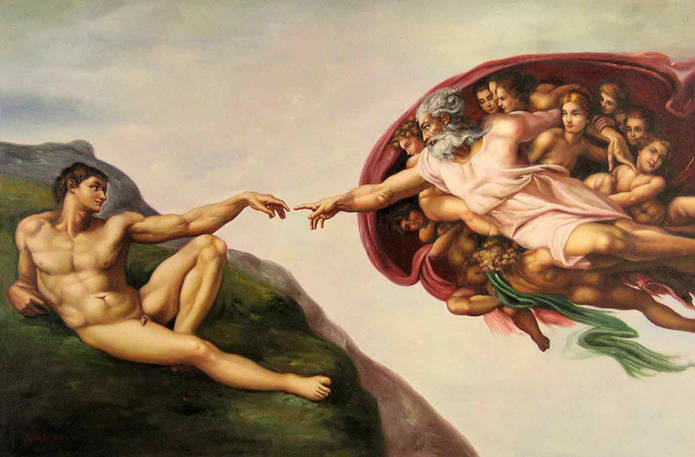


Aqueducts, domes, archways, the sewer system, music instructions (such as adagio or poco mosso), the Times New Roman font, the Roman calendar (which basically is the calendar we follow now) are just a few of the Italian cultural contributions to the world. Just a few of the examples Professor Enrico Bruschini, the official art historian to the American Embassy in Rome [2], was able to introduce to the audience of the Italian Cultural Institute of NY [3] during the conference, presented by ILICA [4], in collaboration with the Italy-America Chamber of Commerce [5], “The Cultural Contribution of Italy to Humanity.”
Part of Ilica's seventh annual Cultural Event in celebration of the 150 year anniversary of the unification of Italy, the conference was rich with anecdotes and curiosities that captured even those who are not history buffs.
“Bruschini embodies Italian culture, that's why he is here today,” Claudio Bozzo, president of the Italy-America Chamber of Commerce said, “Italy right now is not in its best shape, the press only features negative news, scandalous facts that see our country on the verge of collapsing. The topic of ILICA's conference is Terroni and Polentoni, something that divided our country in two but we want to show Italy as one, it gets united under an artistic/cultural point of view".
Dozens of businessmen, intellectuals and art lovers attended the event, all curious to hear what the gentleman who has shown the wonders of Rome to some of the most powerful men in the world had to say.
Professor Bruschni indeed is a spring of information to all those who want to discover the secrets of the Vatican and Rome’s treasures. For 25 year he was the Fine Art Curator and Official Art Historian of the American Embassy in Rome. He has written several books, among them “In the Footsteps of Popes,” a book that is considered THE guide par excellence to the Vatican Museums [6]. In it, Professor Bruschini has written about new discoveries but he has also “filled some blanks, and given new interpretations to some of the world’s most cherished work of arts, trying to understand the ideas behind them.”
An example? Bruschini's interpretation of Michelangelo's Pietà, an interpretation that the Church is not too crazy about. Looking carefully at an image of the marble statue we can see how young the Virgin Mary is, way too young to be there with Jesus at the moment of his death. “That means that the image is a prediction, something that has not happened yet but that will take place in the future, when Jesus is a grown man,” Bruschini believes.
Michelangelo was a favorite topic during the evening and several of his works were carefully dissected... and a dissected brain is the topic of another curiosity: “In 1990, physician Frank Meshberger published a paper in the Journal of the American Medical Association [7] deciphering Michelangelo's imagery with the stunning recognition that the depiction in God Creating Adam in the central panel on the ceiling was a perfect anatomical illustration of the human brain in cross section. Meshberger speculates that Michelangelo surrounded God with a shroud representing the human brain to suggest that God was endowing Adam not only with life, but also with supreme human intelligence,” Doctor Douglas Fields, neurobiologist, writes in the Huffington Post [8]... and Professor Bruschini agrees. “God gives Adam the gift of life, but also the gift of intelligence,” he explains, “And let me add another curiosity, as I was showing this to an American tourist, who happened to be a gynecologist, she pointed out how it was a womb, the nest of all humanity.”
The stories to be told were many, the time available, little... but the professor could also discuss a statue by Giambologna found by chance at the American Embassy in Rome (once a private park of Giulio Cesare, then summer residence of Roman Emperors, of Cardinal Ludovisi and of Queen Margherita... yes! The one who invented Pizza Margherita!) and the Italian roots of New York City.
Professor Bruschini presented the audience with the seal of the city of New York, where one reads “Sigillum civitatis novi erboraci,” which means “The seal of the City of New York.” “Erboracum” was indeed the Roman name for York. “There are so many Italians who played a fundamental role in America’s history; from Giovanni da Verrazzano to Cristoforo Colombo, and Amerigo Vespucci,” he had to add.
And one more thought before bidding farewell... “History is a teacher, learn your lessons to what happened years ago.”
Source URL: http://ftp.iitaly.org/magazine/focus/art-culture/article/cultural-contribution-italy-humanity
Links
[1] http://ftp.iitaly.org/files/bruschinigrande1321047501jpg
[2] http://italy.usembassy.gov
[3] http://www.iicnewyork.esteri.it/IIC_NewYork
[4] http://www.ilicait.org
[5] http://www.italchamber.org
[6] http://www.vaticanstate.va/EN/Monuments/The_Vatican_Museums
[7] http://jama.ama-assn.org
[8] http://www.huffingtonpost.com